Microsoft Surface Pro Review
by Anand Lal Shimpi on February 5, 2013 9:00 PM ESTSurface Pro as a Tablet
If you can get over the bulk, Surface Pro is easily the fastest tablet on the market today. Apple has done a great job of making relatively slow hardware feel very fast with iOS, but Surface Pro brute forces its way to the top. Web pages load quicker than on any ARM based tablet and multitasking is just awesome on the device. This is where the power of Intel’s Core microarchitecture really comes into play.
Since the introduction of the 3rd generation iPad with Retina Display several folks have pointed out to me that UI frame rate isn’t always so smooth on the device. I personally never noticed because I found that most of the competition was even worse, so it always seemed relatively smooth to me. After playing with Surface Pro however and going back to even the 4th gen iPad all of the sudden frame rate stutters are much more noticeable. Playing around with Bing maps on Surface Pro vs. RT is like night and day. Even if you compare scrolling and zoom performance to native iOS maps on the iPad 4, Surface Pro wins out.
Scrolling in web pages, application install time, file copy time, everything is just significantly faster on Surface Pro than on any competing tablet. Oh, and it boots (from full power off) in less than 10 seconds. It’s really the combination of the great CPU performance and fast SSD that deliver the responsiveness of the Surface Pro.
We’re still lacking good cross-platform performance tests, but there are a few browser based benchmarks that I can use to highlight just how much faster Surface Pro is compared to anything ARM based on the market today:
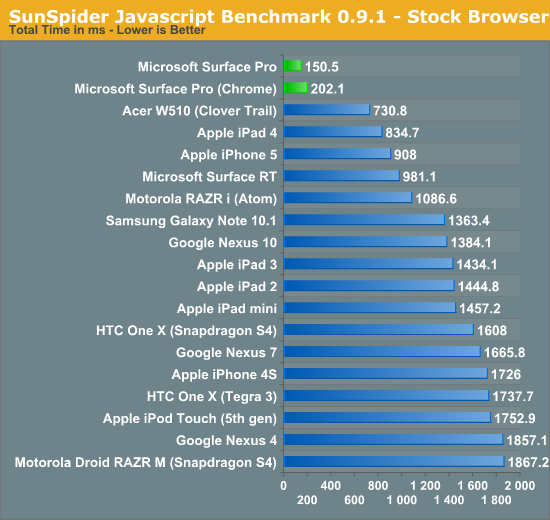
SunSpider is our tried and true quick js benchmark, and here we see huge scaling as we move to Intel's Core i5. Regardless of browser used you're seeing a significant improvement in performance that directly translates to faster web page load times.
Moving on we have Kraken, a seriously heavy javascript benchmark built by Mozilla. Kraken focuses on forward looking applications that are potentially too slow to run in modern browsers today. The result is much longer run times than anything we've seen thus far, and a very CPU heavy benchmark:
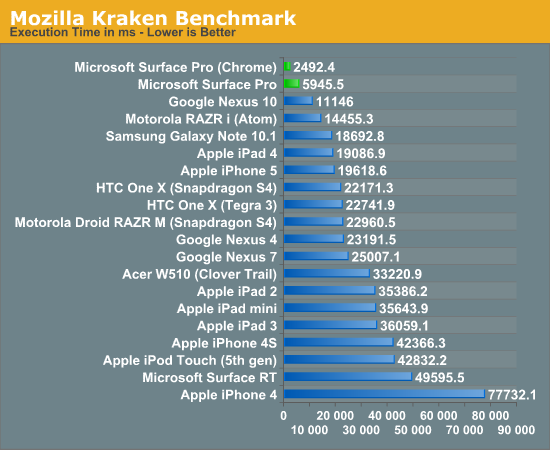
Even when handcuffed by modern IE10 you're looking at almost twice the performance of the Nexus 10. Level the playing field with Chrome as a browser and now Surface Pro completes the test in a bit more than 1/8 of the time of the iPad 4, or 1/4 of the time of the Nexus 10.
Surface Pro manages to deliver almost 5x the performance of the iPad 4 here.
We have one last web-based benchmark: WebXPRT by Principled Technologies (PT). WebXPRT measures performance in four HTML5/js workloads:
Photo Effects: Measures the time to apply effects to a set of six photos. The filters are Sharpen, Emboss, and Glow. WebXPRT applies each filter to two photos. This test uses HTML5 Canvas 2D and JavaScript.
Face Detect: Measures the average time to check for human faces in a photo. WebXPRT runs this test on five photos and uses the average time to calculate the final result. This test uses HTML5 Canvas 2D to get access to photo data. The detection algorithm is implemented in JavaScript.
Stocks Dashboard: Measures the time to calculate financial indicators of a stock based on historical data and display the result in a dashboard. The calculations are done in JavaScript, and the calculated stocks data is displayed using HTML tables and Canvas 2D.
Offline Notes: Measures the time to store notes securely in the browser's HTML5 local storage and display recent entries. This test uses using AES for security.
We're reporting the overall score after all tests have been run:
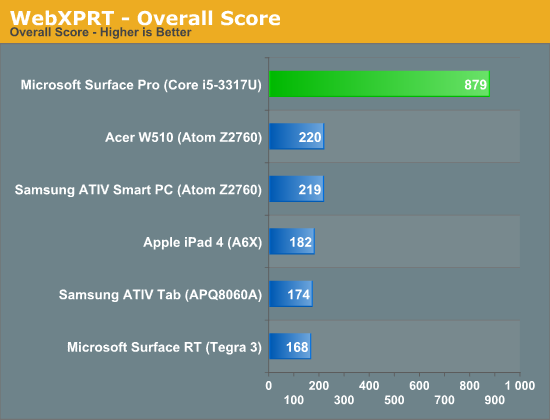
Next up are another set of benchmarks from PT, but unlike the WebXPRT suite these tests don't run in a browser. Once again we're looking at performance in a handful of tasks designed to stress the CPU. Here the performance advantage continues to be quite significant. While Surface RT and the other Windows RT/8 devices still feel a bit sluggish, I have no performance complaints whatsoever about Surface Pro:

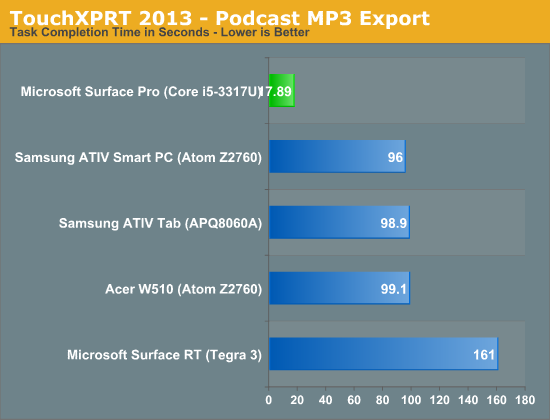
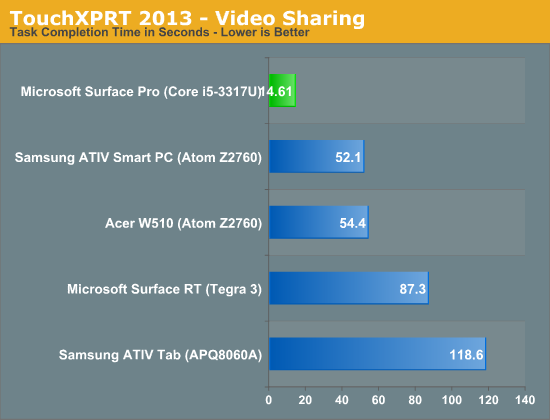
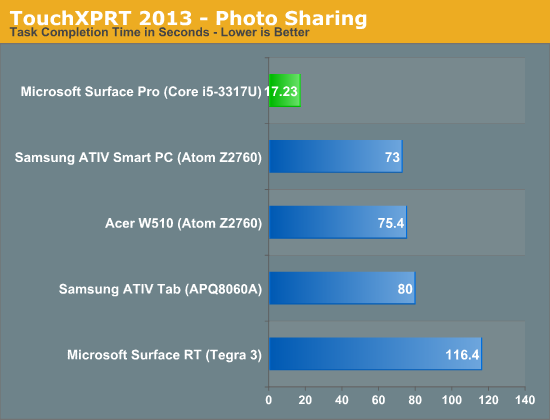
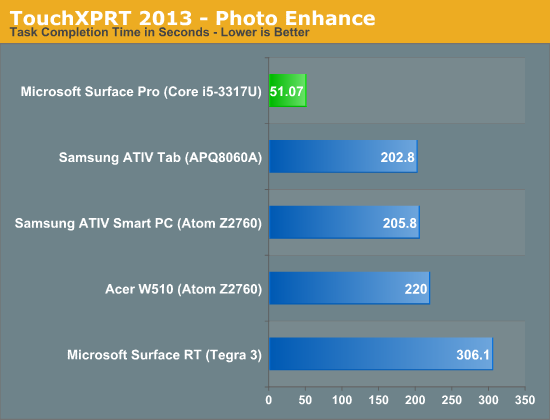
If I had any complaints about using Surface Pro as a tablet outside of weight, they’d be about Windows 8. There are still far too many bugs and quirks in the OS that just don’t make sense. I’ve outlined some of my issues with Windows 8 before. I think the UI works just fine for a tablet, it’s just the unfinished touches that need attention. For example, having to gesture in modern IE10 before being able to switch between tabs seems silly.

This still happens way too often in the Windows Store, no indication of what's going on just a blank screen
On the bug-front, all too often I’ll wake up the system only to have the lock screen upside down. And despite all of the extra performance under the hood, the time from when you hit the power/lock button to when something appears on the screen is just longer than on an iPad or Android tablet. We’re not talking several seconds, but it’s still noticeably longer.










228 Comments
View All Comments
amrs - Wednesday, February 6, 2013 - link
I'm also wondering why the SSD benchmark showed only throughput? No 4k random access or access time tests?jack.fxx - Wednesday, February 6, 2013 - link
Surface Pro has 5 times greater performance than competing ARM tablets with half battery life.nangryo - Wednesday, February 6, 2013 - link
Considering cellular cell draws more power. I think you should separate the result of the wifi test and cellular test. Because makes the Galaxy Tab chart below Surface whilst it is using cellular connection makes it a bit inaccuratemaximumGPU - Wednesday, February 6, 2013 - link
can someone block this douche who's been polluting a lot of AT's threads?milli - Wednesday, February 6, 2013 - link
After reading this review, I have to conclude that Intel is ahead of ARM in regards to power efficiency on every front. Before this review, it was obvious that Clover Trail is competitive to the current ARM offerings on power usage and speed. And it's soon to be upgraded with the Silvermont core and 22nm.But Intel's i5 ULV seems to be better at performance/watt too. >5x faster while offering half the battery life. Even on a TDP level compared to Exynos 5 it's twice the power (8W vs 17W) while offering >4x the performance on the cpu front and at least 2-3x the performance on the GPU.
With Haswell and 22nm Atoms coming, it's seems ARM's stand against Intel is going to be more short lived than many believed.
LetsGo - Wednesday, February 6, 2013 - link
In your dreams, the Nexus 10 drives a much higher resolution then the surface pro and is the first iteration of A15's. ARM chips will undercut Intel's and deliver just as good performance because the real heavy work is done in the GPU.Watch Intel's share price drop in the coming years.
Netscorer - Wednesday, February 6, 2013 - link
Your conclusion is wrong. Clover Trail may have matched ARM power consumption but is still below the par on performance and is completely pathetic in GPU performance. To add insult to injury, it is priced substantially higher then ARM chips, so good luck seeing it in many mobile devices.Ivy Bridge is the top dog in performance but is still far from being optimized for power consumption. Haswell will (we all hope) change that but again, at much much higher prices then ARM design. When you have a CPU alone cost $250, forget about building budget tablets around it.
kyuu - Thursday, February 7, 2013 - link
What? Clover Trail is faster than any ARM SoC except for A15 -- and A15s use more power than Clover Trail.powerarmour - Wednesday, February 6, 2013 - link
$899 for a 64GB SSD with only 23GB free space... Give me a break...amdwilliam1985 - Wednesday, February 6, 2013 - link
$499 for 16GB with only 13GB free space... what the heck...Consumers should spend 2x$499 to get 26GB free space, haha this way they can beat surface pro in terms of non-removable space, lol.
On the other hand, feel free to insert SD card, USB flash, USB 3.0 external, NAS and etc...
What does the $499 offer you? They'll accuse you of stealing mp3, mp4, mp5 or whatever else they can accuse you of stealing. Yesterday they're telling you that you're holding it wrong, today they're calling you using the device the wrong way, I guess tomorrow they'll just call you stupid plain and clear so it's dummy proof ;)